Main Injection
-
- Making the Case for LPG as a Marine Fuel Maritime Reporter, Oct 2018 #26
The sulfur emission control areas (SECAs) in place in North-America and Northern Europe, in combination with the upcoming global 0.5% limit on sulfur in 2020 (or 2025) and similar EU limits in 2020, call for alternative fuels as a means for compliance. Several alternative fuels are available and, at the same time, new fuel oil products with very low sulfur content have been introduced.
In this respect, the ability of the new MAN ME-LGIP engine to run on LPG, which is a sulfur-free fuel, offers great potential for compliant ship operation within SECA zones.
The use of LPG as the fuel in MAN B&W two-stroke engines will reduce the C02 emission by up to 13%, when compared to MDO and up to 18% when compared to HFO. As an additional feature, the LPG engine has great potential for being a solution to handle the volatile organic compound (VOC) issue in shuttle tankers and other crude oil carriers as the engine holds novel options for burning the liquid volatile organic compound (LVOC) of the VOC. The engine can burn any mixtures of propane and butane, and furthermore, the mixture can contain significant amounts of ethane. All heavier hydrocarbons normally contained in the LVOC can also be used.
Both gas carriers and container ships would be potential customers for the multi-gas engine. René Sejer Laursen, promotion manager, dual-fuel engines, MAN Energy Solutions noted that gas carriers are already installing tanks capable of holding LPG, LNG and ethane (although not mixed together), and an engine that could burn all these fuels would be a considerable advantage.
“The potential for containerships to use the fuel is also considerable”, Laursen said. He argued that operators had shied away from LNG because it often ties them to one supplier. The ability to use several fuels would give them a competitive advantage by allowing them to select the cheapest fuel at a given port, as well as ensuring compatible fuels are available at a wider selection of ports.
The Introductory Event
Against this background MAN Energy Solutions has revealed its latest two-stroke engine type, a dual-fuel MAN B&W ME-LGIP engine designed for LPG running, at a ceremony in Copenhagen on 3rd of September attended by its Chief Sales Officer, Wayne Jones, along with a large crowd of customers and business partners. The event was hosted by MAN Energy Solutions’ Thomas Knudsen, Head of the Two-Stroke business unit, and Bjarne Foldager, Vice President Sales & Promotion – Two-Stroke business unit.Foldager said: “Interest in using LPG as a fuel, within and outside of the LPG carrier segment, is growing due to its sulfur-free character, widespread availability and ease of bunkering. In gas mode, the ME-LGIP engine operates on just 3% pilot oil and down to 10% load. Ultimately, we expect the engine to operate without the need for pilot oil.”
MAN Energy Solutions expects a strong demand for the ME-LGIP engine from very large gas carriers (VLGCs) and coastal vessels from its introduction.Foldager added: “The ME-LGIP can also burn liquid volatile organic compounds, a deliberate move on our part since the IMO will inevitably turn its focus towards the reduction of volatile organic compounds in the future. Accordingly, we view the ME-LGIP as also ideally suited to the propulsion of shuttle tankers and very large crude carriers.”
The diesel principle provides the ME-LGIP engine with high operational stability and efficiency, including during load changes and fuel change-over, while defining properties such as a stable change-over from one fuel type to another with no fuel-penalties are maintained. The negligible gas slip of the ME-LGIP engine makes it the most environmentally friendly, two-stroke technology available.
MAN ES also reports that the ME-LGIP engine has experienced an up to 18% reduction in CO2 and circa 90% reduction in particulate matter when running on LPG, compared with HFO.
One Engine Fits All
As has been explained during the introductory event in Copenhagen the MAN B&W ME-LGIP is the only liquid gas injection dual-fuel engine on the market, allowing to switch between conventional HFO, MGO and LPG fuels with no loss to performance. Not only does this help to maximize ROI, but with zero sulfur in LPG and 13% less CO2 from LPG fuel, ship owner stay comfortably within emissions limits.
The compact liquid gas injection system means the MAN B&W ME-LGIP could also be an ideal retrofit solution for existing fleets. The technology can be applied to all types of ships with an ME-C engine of bore size equal to or bigger than 500 mm. LPG gas carries are likely retrofit candidates.
Furthermore, the ME-LGIP engine is flexible with regard to LPG composition and finds even LPG qualities containing significant amounts of ethane acceptable.The ME-LGI (-Liquid Gas Injection) concept can be applied to all MAN Energy Solutions low-speed engines from 500-bore and up, either ordered as an original unit or through retrofitting.
The primary characteristics of ME-LGIP engines include:
The engine works according to the two-stroke cycle and comes with numbers of cylinders from 5 to 12 depending on bore size (bore: 500 mm to 950 mm); whereby the stroke/bore ratio is: 3.6 to 5.0.
With this the specified maximum continuous power range is of 5,350 kW to 82,440 kW.
The engine features:
* a low-pressure supply system;
• a fuel-injection system similar to that most recently developed for MAN ES conventional MDO/HFO engines – the FBIV (Fuel Booster Injection Valve): this innovative fuel booster, specially developed for the ME-LGI engine, ensures that a low-pressure fuel-gas supply system can be employed, significantly reducing first-time costs and increasing reliability,
• an injection pressure of 500-600 bar
• the ability to handle low-sulfur/low-flashpoint fuel types: methane, methanol, ethanol, LPG, and dimethylether (DME).
• Turbocharging system
• High efficiency constant pressure turbocharging systems with MAN, ABB or MHI turbochargers as standard
• Engine automation and control
• In-house developed gas safety and control system
• Fuel oil system
• Common injection system for pilot oil and for main injection
• Gas system
• LPG injection by fuel booster injection valves (FBIV)
According to MAN ES it comes without saying that the new MAN B&W ME-LGIP engine fulfills the following exhaust regulations:
* IMO Tier II and also IMO Tier III (with SCR, EGR or EcoEGR*). ( *): for improved efficiency when operating in Tier II mode.)
Summary
The ME-LGI came about due to interest from the shipping world in operating on alternatives to HFO. Methane, Methanol and LPG carriers have already operated at sea for many years and many more LPG tankers are currently being built as the global LPG infrastructure grows. With a viable, convenient and comparatively cheap fuel already onboard, it makes sense to use a fraction of the cargo to power the vessel with an important, side-benefit being its positive, environmental performance.
* The ME-LGIP engine operates with the same efficiency as the ME-C engine
* The ME-LGIP engine will consume LPG as main fuel and uses HFO as pilot oil
* Seamless change over from gas to fuel and vice versa
* Possible to run on any gas/fuel mix, fuel flexibility
-
 )
April 2024 - Maritime Reporter and Engineering News page: 39
)
April 2024 - Maritime Reporter and Engineering News page: 39& Solutions to a “Wall Espen Andersen, a pilot boat driver CClimbing Robot” from Sumitomo Heavy LEGO Pilot Boat for DanPilot, the independent public Main Particulars Industries, Ltd., Mitsui O.S.K. Lines, Ltd., and Bricks: 2500 pcs. enterprise owned by the Danish state, MOL Ship Management Co., Ltd
-
 )
April 2024 - Maritime Reporter and Engineering News page: 32
)
April 2024 - Maritime Reporter and Engineering News page: 32, says Green. ment, certainly in Western Europe.” The development of the ? oating wind industry will be differ- The crane will have two hooks, one on the main boom and ent to that of ? xed wind. The subsidies won’t be a plentiful, and then a second on a luf? ng jib. This reduces the time it would there
-
 )
April 2024 - Maritime Reporter and Engineering News page: 21
)
April 2024 - Maritime Reporter and Engineering News page: 21regulatory and environmental hur- ect work globally. dles, they are not alone. About ? ve years ago he made the switch over to offshore “One of the main risks I see is the onshore infrastructure to wind, working for Worley as senior director of offshore wind, support fabrication, staging, O&M along
-
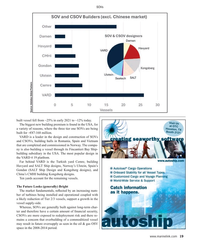 )
April 2024 - Maritime Reporter and Engineering News page: 19
)
April 2024 - Maritime Reporter and Engineering News page: 19, Norway’s Ulstein, Spain’s Gondan (SALT Ship Design and Kongsberg designs), and China’s CMHI building Kongsberg designs. Ten yards account for the remaining vessels. The Future Looks (generally) Bright The market fundamentals, re? ected by an increasing num- ber of turbines being installed and operational
-
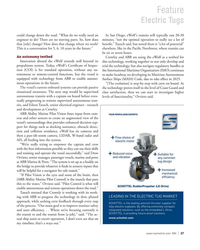 )
April 2024 - Marine News page: 37
)
April 2024 - Marine News page: 37with its work- ing with ABB to progress the technology in slow, phased approach, while seeking crew feedback through every step of the process. “Our main goal is to improve mariner safety and asset ef? ciency. . . Where we’re focusing currently is the transit to and the transit from [a job],” said
-
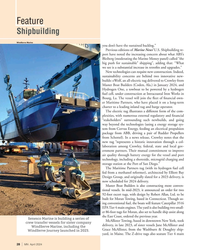 )
April 2024 - Marine News page: 28
)
April 2024 - Marine News page: 28Allan, Ltd. to be built for Moran Towing, based in Connecticut. Though us- ing conventional fuel, the boats will feature Caterpillar 3516 EPA Tier 4 main engines. The yard is also building two small- er 86-foot tugs for Moran, also set to handle ship assist along the East Coast, ordered the previous
-
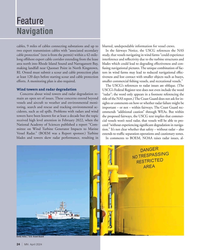 )
April 2024 - Marine News page: 24
)
April 2024 - Marine News page: 24text does not even include the word Concerns about wind towers and radar degradation re- “radar”; the word only appears in a footnote referencing the main an open set of issues. These concerns extend beyond title of the NAS report.) The Coast Guard does not ask for in- vessels and aircraft to weather
-
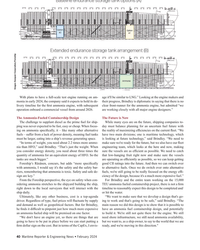 )
February 2024 - Maritime Reporter and Engineering News page: 40
)
February 2024 - Maritime Reporter and Engineering News page: 40alternative the reality of maximizing ef? ciencies on the current ? eet. “We fuels – suffer from a lack of power density, meaning fuel tanks have two main divisions; one is maritime technology, which must be larger, eating into a ship’s revenue generating space. is looking at future technology,” said
-
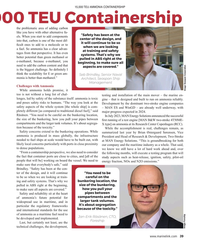 )
February 2024 - Maritime Reporter and Engineering News page: 39
)
February 2024 - Maritime Reporter and Engineering News page: 39with Ammonia Image Seaspan Corporation While ammonia holds promise, it too is not without a long list of chal- testing and installation of the main mover – the marine en- lenges, led by safety of the substance itself: ammonia is toxic gine – that is designed and built to run on ammonia reliably
-
 )
February 2024 - Maritime Reporter and Engineering News page: 36
)
February 2024 - Maritime Reporter and Engineering News page: 36as part one propulsion line with the shaft generator providing about of a hybrid propulsion system. By combining a Wärtsilä 26 5MW of electric power. main engine with batteries, PTI/PTO and an intelligent energy Payback time for ABB’s PTI/PTO system is ? ve years at management system, along with electrically
-
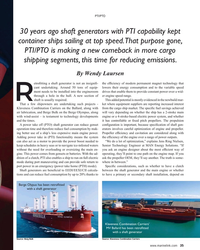 )
February 2024 - Maritime Reporter and Engineering News page: 35
)
February 2024 - Maritime Reporter and Engineering News page: 35. The speci? c fuel savings achieved air lubrication, and Berge Bulk on the Berge Olympus, along will vary depending on whether the ship has a 2-stroke main with wind-assist – is testament to technology developments engine or a 4-stroke-based electric power system, and whether and the times. it has controllabl
-
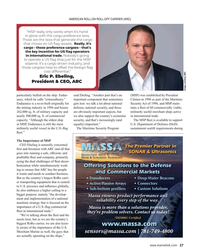 )
February 2024 - Maritime Reporter and Engineering News page: 27
)
February 2024 - Maritime Reporter and Engineering News page: 27Clinton in 1996 as part of the Maritime Endurance is a ro-ro built originally for gets lost: we talk a lot about national Security Act of 1996, and MSP main- the mining industry in 1996 and boasts defense, national security, and those tains a ? eet of 60 commercially viable, 262,000 sq. ft. of military
-
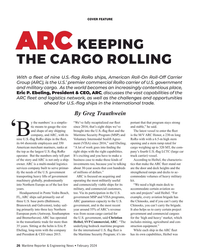 )
February 2024 - Maritime Reporter and Engineering News page: 26
)
February 2024 - Maritime Reporter and Engineering News page: 26, predominantly operating the most militarily useful kit. into Northern Europe as of the last few and commercially viable ships for its “We need a high main deck to years. military, and commercial customers, accommodate certain aviation as- Headquartered in Ponte Vedra Beach, too. Via its participation
-
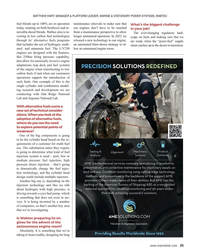 )
February 2024 - Maritime Reporter and Engineering News page: 25
)
February 2024 - Maritime Reporter and Engineering News page: 25MATTHEW HART, MANAGER & PLATFORM LEADER, MARINE & STATIONARY POWER SYSTEMS, WABTEC fuel blends up to 100% are in operation maintenance intervals to make sure that What’s the biggest challenge today, running on both biodiesel and re- our engines don’t have to be touched in your job? newable diesel blends.
-
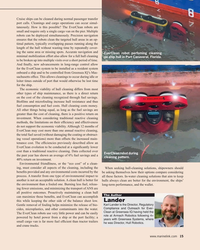 )
February 2024 - Maritime Reporter and Engineering News page: 15
)
February 2024 - Maritime Reporter and Engineering News page: 15times outside of port that would otherwise be lost time for the ship. The economic viability of hull cleaning differs from most other types of ship maintenance, as there is a direct return on the cost of the cleaning recognized through fuel savings. Bio? lms and microfouling increase hull resistance
-
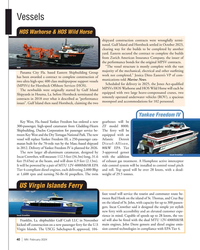 )
February 2024 - Marine News page: 40
)
February 2024 - Marine News page: 40Gulf Craft LLC in November sel will also be ? tted with the dual MTU 12V-4000M65R kicked off construction on a new passenger ferry for the U.S main engines, John Deere gensets and diesel engine emis- sion control technologies in compliance with EPA Tier 4. Virgin Islands. The USCG Subchapter-K approved
-
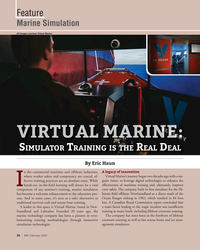 )
February 2024 - Marine News page: 34
)
February 2024 - Marine News page: 34survival craft and rescue boat training. lost. A Canadian Royal Commission report concluded that A leader in this space is Virtual Marine, based in New- a main factor leading to the tragic incident was insuf? cient foundland and Labrador. Founded 20 years ago, the training at many levels, including lifeboat
-
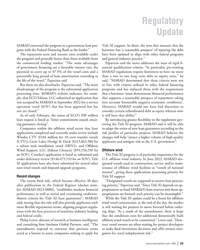 )
February 2024 - Marine News page: 33
)
February 2024 - Marine News page: 33with other federal programs the program and generally better than those available from and general industry practice.” the commercial lending market. “The main advantages Papavizas said the move addresses the issue of rigid
-
 )
January 2024 - Marine Technology Reporter page: 56
)
January 2024 - Marine Technology Reporter page: 56working on the pre-FEED, and now we’re go- clude 70 turbines of 15MW each, and has preselected Gazelle ing to be working on the engineering portion. Our main goal as one of the providers for the offshore wind platform. So, is to prove the concept,” said Ortega. Apart from the technical, we’re not only
-
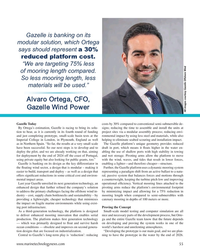 )
January 2024 - Marine Technology Reporter page: 55
)
January 2024 - Marine Technology Reporter page: 55on second genera- world’s harshest and unrelenting atmospheres. tion designs that are focused on industrialization. “Developing the prototype is our main goal, and we are plan- Central to Gazelle’s long-term play is ‘reduction’: reducing ning to have the prototype in the water by the end of 2026. www
-
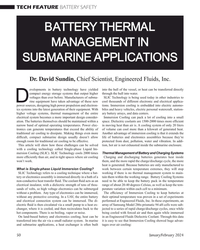 )
January 2024 - Marine Technology Reporter page: 50
)
January 2024 - Marine Technology Reporter page: 50system becomes a more important design consider- Immersion Cooling can pack a lot of cooling into a small ation. The batteries themselves should be maintained within a space. Dielectric coolants are 1500-2000 times more ef? cient narrow band of optimal operating temperatures. Power elec- in moving
-
 )
January 2024 - Marine Technology Reporter page: 16
)
January 2024 - Marine Technology Reporter page: 16in our everyday lives. Ensur- the coast of Costa Rica. By taking this collaborative approach ing that the systems we use are ? t for the future is vital to main- it meant that assets and resources were shared across the na- tain a competitive and collaborative edge on our marine research tions. It was cost
-
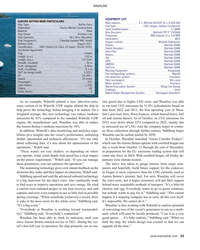 )
January 2024 - Maritime Reporter and Engineering News page: 33
)
January 2024 - Maritime Reporter and Engineering News page: 33WASALINE EQUIPMENT LIST AURORA BOTNIA MAIN PARTICULARS Main engines: 4 × Wärtsilä 8V31DF (4 × 4,400 kW) Ship Type: RoPax Ferry Fuel type: LNG, biogas, battery (Leclanche) Shipbuilder: Rauma Marine Constructions Total installed power: 17,6MW Material: Steel Bow thrusters: Wärtsilä FPP
-
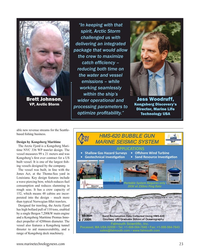 )
November 2023 - Marine Technology Reporter page: 23
)
November 2023 - Marine Technology Reporter page: 23than typical Norwegian ? llet trawlers. Designed for trawling, the Arctic Fjord has high bollard pull of 110 tons, enabled by a single Bergen 7,200kW main engine Sand Reclamation Data Collected Using HMS-620 and a Kongsberg Maritime Promas Inno- Courtesy URI Graduate School of Oceanography duct propeller
